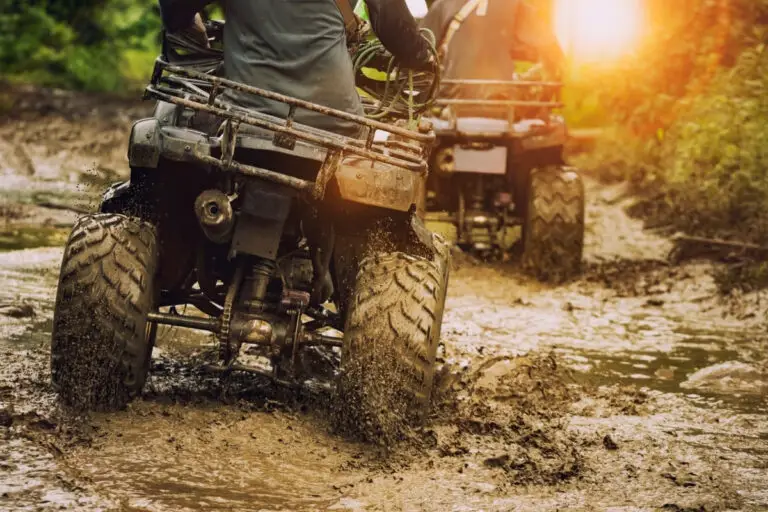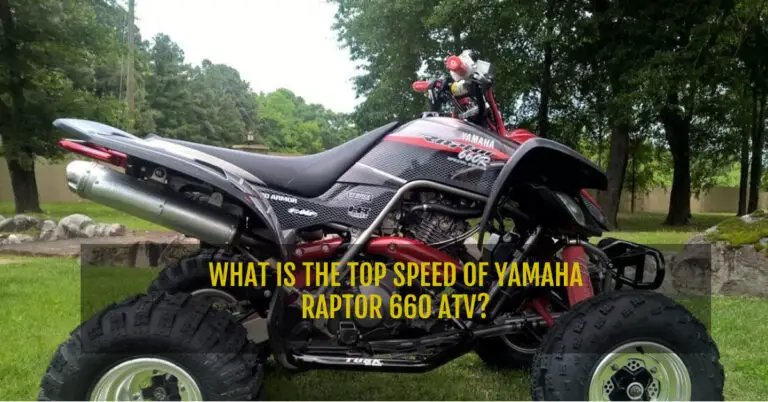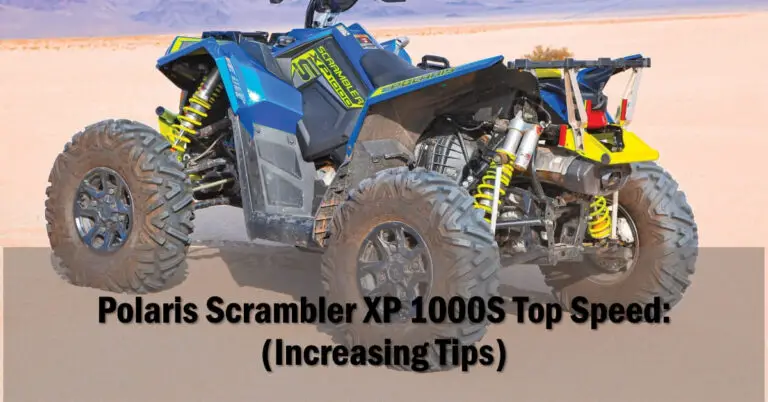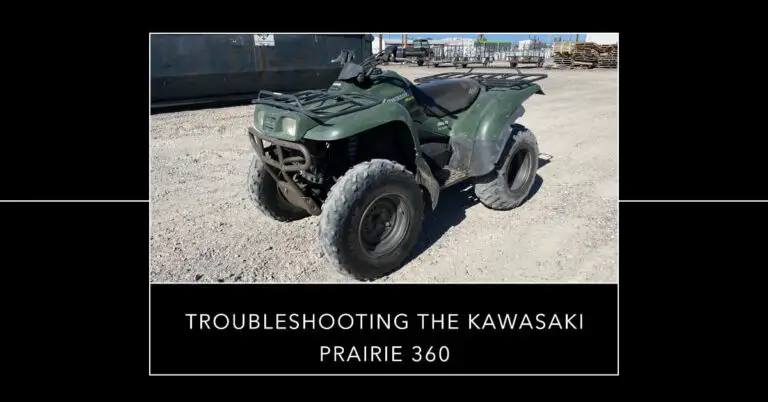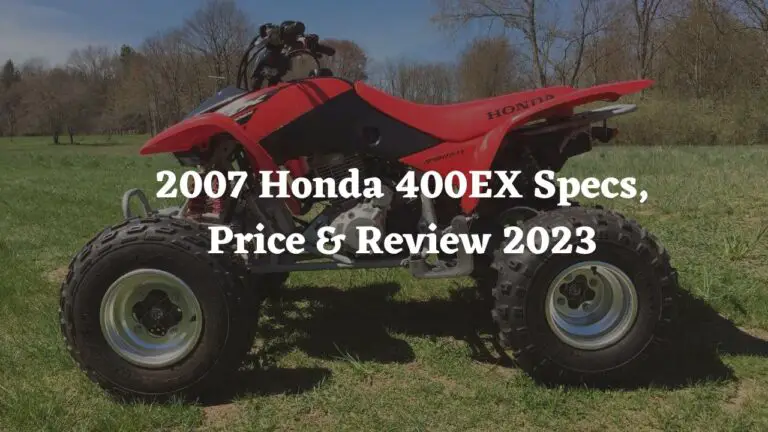Can-Am Outlander Top Speed & Make Faster

The Can-Am Outlander is known for its powerful performance and exhilarating speed capabilities. But just how fast can these nimble ATVs go when you hit the throttle and open it up? In this in-depth guide, we’ll look at the top speed specs for different Outlander models and discuss the key factors that affect maximum velocity.
Table of Contents
An Overview of Can-Am Outlander ATVs
First, let’s take a quick look at what makes the Outlander line of ATVs so popular among recreational riders and utility users alike:
The Can-Am Outlander is a sporty 4-wheel drive ATV available in two-seat and solo seat configurations. Key features include:
- Powerful Rotax V-twin engines from 400cc to 1000cc
- Smooth, variable transmission for optimal acceleration
- Double A-arm front suspension with up to 10 inches of travel
- Torsional Trailing arm rear suspension for stability
- Visco-Lok auto-locking front differential for traction
- Tri-mode dynamic power steering for effortless turning
- Generous towing and cargo capacity
- Available winches, racks, tire, and suspension upgrades
With its responsive handling and brawny power delivery, the Outlander is ready for both trail riding and utility use. Next let’s see how the different models measure up when it comes to top speed.
Outlander MAX Top Speed
The Can-Am Outlander MAX is the 2-up model built for recreational trail riding with a passenger. Here are the top speeds for key MAX variants:
- Outlander MAX 650/800R: Up to 50 mph
- Outlander MAX XT: Up to 62 mph
- Outlander MAX XT-P: Up to 63 mph
The larger displacement engines and upgraded performance packages on the XT trims allow the MAX to surpass 60 mph at its maximum velocity. While not as fast as the solo seat models, the MAX has more than enough power for enjoying trails with a partner.
Outlander Top Speed
The solo seat Outlander quads are designed for quick acceleration and versatility. Here are the top speeds by model:
- Outlander 400: Up to 46 mph
- Outlander 570: Up to 60 mph
- Outlander 850: Up to 65 mph
- Outlander 1000R: Up to 68 mph
The powerful V-twin engines on the 850 and 1000cc models push the Outlander well over 60 mph when you open the throttle. The light weight and sporty handling let it carry speed on trails.
What Factors Affect the Outlander’s Top Speed?
The maximum speed capabilities of any ATV depend on several key factors:
- Engine size – Not surprisingly, larger displacement engines produce more horsepower and torque, which translates to higher top speeds. The 1000R makes 82 hp vs. the 650’s 50 hp.
- Transmission and gearing – The CVT and final drive gear ratios affect acceleration and top end velocity. Lower ratios favor acceleration while higher ratios allow higher max speeds.
- Terrain – Soft sand or mud will quickly sap momentum compared to smooth, hard packed dirt or gravel where an ATV can better maintain velocity.
- Riding weight – Carrying more gear, cargo, or an extra passenger will weigh down an ATV and reduce potential top speed. Light solo riding will be fastest.
- Maintenance – A finely tuned engine operating at peak efficiency produces better top end performance. Stay on top of maintenance.
- Tire pressure – Running tires at the optimal inflation level reduces rolling resistance allowing higher speeds.
- Riding style – Opening up the throttle fully vs. moderate partial throttle application makes a difference in velocity. An aggressive riding style yields the highest speeds.
So while the capable Can-Am Outlander ATVs are ready for speed, real world maximums will depend on the factors above. Next let’s look at whether top speed is even an important metric for ATV buyers.
Is Top Speed Really That Important for ATVs?
While fun for short bursts, all-out top speed is generally not the most important performance consideration for ATV riders. Here’s why:
- Technical prowess – capabilities like suspension travel, ground clearance, 4WD traction, and slow speed handling are more vital for navigating rough trails.
- Towing/cargo capacity – Being able to haul equipment, gear, or a trailer with a powerful, controlled tow is essential for utility use.
- Off-road handling – ATVs need precise steering and stability at slower technical speeds where outright speed causes issues.
- Safety – High speed riding greatly increases the risks of impact injuries and rollovers if an obstacle or turn appears. Focusing on speed over safety is dangerous.
For these reasons, responsible ATV riders prioritize control, technical abilities and practical performance over all-out speed and acceleration. Operating at unsafe velocities quickly increases the risks of crashes and roll-overs on off-road terrain. Careful throttle control and reasonable speeds should always be the priority.
Outlander Top Speed Specifications Chart
| Model | Engine | Max. Speed |
|---|---|---|
| Outlander 400 | 400cc, 30 HP | 46 mph |
| Outlander 570 | 570cc, 48 HP | 60 mph |
| Outlander 650 | 650cc, 50 HP | 63 mph |
| Outlander 850 | 854cc, 78 HP | 68 mph |
| Outlander 1000R | 976cc, 82 HP | 68 mph |
| Outlander MAX 400 | 400cc, 30 HP | 44 mph |
| Outlander MAX 650 | 650cc, 50 HP | 50 mph |
| Outlander MAX XT-P | 650cc, 50 HP | 63 mph |
Outlander Acceleration and Power
In addition to top speed, the Can-Am Outlander also delivers excellent acceleration and power for quick trail response. Here are some specs:
- 0-30 MPH: Right around 2 seconds for most models
- 0-60 MPH: Models with 500cc+ engines can reach 60 MPH in under 5 seconds
- Horsepower: Ranges from 30 HP on the 400 to up to 82 HP on the Outlander 1000R
The combination of ample low-end torque from the V-twin design and a responsive CVT transmission allows the Outlander to leap forward when you hit the gas, kicking up debris as it surges ahead.
The Outlander can tow up to 1500 pounds on some models, which requires strong acceleration when getting a loaded trailer moving from a standstill. Slow speed power matters most for towing.
tips for safely increasing the top speed of your Can-Am Outlander ATV
- Gearing changes – Installing a higher ratio rear sprocket or changing final drive gearing can produce more top end speed. Just be careful not to sacrifice too much low end power.
- Exhaust mods – A full performance exhaust system like those from Yoshimura, Muzzy, or HMF can add 1-3 mph peak speed in some cases. But check noise regulations.
- Air intake mods – Adding an aftermarket air intake kit can improve airflow allowing more speed. Make sure to get a pre-oiled foam filter.
- ECU tuning – Getting a professional fuel controller tune optimized for top speed gains can help maximize velocity. Adds cost but effective.
- Reduce weight – Shedding unnecessary weight by removing racks, etc. and traveling lighter reduces drag. But safety first.
- Tire pressure – Make sure your tires are inflated to the max PSI rating on the sidewall for lowest rolling resistance.
- Slip-on tire chains – At low speeds on pavement,Chains can gain 1-2 mph. Don’t use at high speeds.
- Ride Solo – Carrying a passenger and gear adds weight and slows you down. Ride lightly for max speed.
Keep in mind that chasing every last mph comes with trade-offs and risks. Focus on smart incremental gains safely within the bike’s capabilities. And never ride beyond your skill level.
Outlander Prices and Model Years
Here is a breakdown of MSRP pricing by model year for key versions of the Can-Am Outlander:
| Model | Years | MSRP Price Range |
|---|---|---|
| Outlander 400 | 2006-2020 | $6,199-$8,299 |
| Outlander MAX 400 | 2009-2020 | $7,649-$10,199 |
| Outlander 500 | 2008-2012 | $7,349-$10,649 |
| Outlander 650 | 2006-2018 | $7,949-$10,949 |
| Outlander 800R | 2008-2014 | $9,149-$12,149 |
| Outlander 850 | 2012-2020 | $9,949-$12,799 |
| Outlander 1000 | 2009-2018 | $11,699-$14,899 |
| Outlander 1000R | 2019-2020 | $15,399 |
Some key takeaways:
- Base MSRP prices range from around $6,000 to $15,000+
- Higher HP models like the 850, 1000, and 1000R command the highest prices
- Recent year models can top over $15k fully loaded
- There are great values to be had on lightly used mid-range models
Where the larger MAX and X mr/XT models excel with upgrades, the base 400 and 570 Outlanders offer budget-friendly pricing. Let’s look closer at the pros and cons of the Outlander line.
Can-Am Outlander Pros and Cons
Pros of the Outlander ATVs:
- Strong acceleration and high top speed capabilities
- Smooth and responsive CVT transmission
- Excellent handling and trail maneuverability
- Comfortable ergonomics and seating
- Double A-arm front suspension soaks up bumps
- Good value pricing on mid-range models
- Towing capacity up to 1500 lbs
- True 4 wheel drive traction and control
Potential Cons:
- No power steering on base models
- Tall seat height may limit shorter riders
- Can feel bulky on tight switchback trails
- Initial quality issues on some models
- No engine braking feature
- Low ground clearance on stock models
The Outlander hits the sweet spot of power, handling, features, and price in the ATV world. For an easy to ride and capable 4×4, it’s hard to beat. Next let’s hear thoughts from real world Outlander owners.
What Owners are Saying About the Can-Am Outlander
The Can-Am Outlander earns solid reviews from most owners for its blend of recreational performance and utility capabilities. Here are some examples of their feedback:
“This ATV is an absolute blast to ride on the trails. The power and handling are top notch. I love the Visco-Lok system that delivers awesome traction even in slippery conditions.”
“I pull a small trailer and haul firewood with my Outlander 650 all the time. It has no problem putting the power down and towing heavy loads up the hills on my property.”
“The Max model has been great for hitting the woods with my girlfriend. Big enough to fit two full size adults comfortably for the entire day.”
“The adjustable suspension lets me fine tune the ride quality. Overall the Outlander soaks up bumps way better than my friend’s Honda.”
“Super easy to ride even as a beginner. It has a predictable power delivery and the steering assists make it feel agile on the trail.
However, a few common complaints include:
“The lack of engine braking worries me when going downhill. Have to ride the brakes more than I’d like.”
“It’s a little tall and heavy feeling in very tight woods riding compared to a true sport ATV.”
“The quality control seems hit or miss. I’ve already had to replace a leaking fuel line.”
“The stock tires don’t provide the traction I want in muddy conditions. Upgraded to more aggressive tires.”
Overall most owners praise the Outlander for its supreme capabilities at a fair price point. Next let’s look at some of the issues and solutions.
Common Can-Am Outlander Problems and How to Fix Them
Like most ATVs, Outlanders can experience a few issues with occasional use. Here are some of the most common problems and how to diagnose and fix them:
1. Leaking Fuel Lines
Some models may develop cracks in the plastic fuel line allowing gasoline to leak out. Replace old plastic lines with more durable rubber fuel line. Inspect lines regularly for cracking.
2. Faulty Fuel Pump
If the engine won’t start or lacks power, the fuel pump may need replaced. Verify fuel pressure at the rail. No pressure indicates a bad pump. Replace with an OEM pump for reliable performance.
3. Burning Oil
Excessive oil consumption points to worn piston rings or valve guide seals. Rebuild the top end with a quality gasket kit to reduce oil burning issues.
4. Blocked Air Filter
A dirty, clogged air filter will restrict airflow to the engine leading to lack of power. Clean the air filter regularly or upgrade to higher flow filter like K&N.
5. Loose Battery Terminals
The battery connections can vibrate loose over rough terrain. This prevents proper starting and power. Tighten terminals and clean with a wire brush.
6. Faulty Cooling Fan
An inoperable cooling fan causes the engine to overheat quickly. Replace the mechanical fan or upgrade to electric for reliability.
With preventative maintenance and prompt issue diagnosis, the Outlander ATVs will provide miles of worry-free fun and utility use for years to come.
Top Alternatives to Consider
The Can-Am Outlander has plenty of competition when it comes to sporty 4×4 ATVs. Here are some of the top alternatives to consider:
- Polaris Sportsman: Similar power and capabilities. More compact feel.
- Yamaha Grizzly: Ultra-reliable reputation. Smooth ride quality.
- Honda Rancher: Proven and beginner-friendly. Large owners community.
- Suzuki KingQuad: Great value pricing. Solid overall performer.
- Arctic Cat Alterra: Impressive suspension travel. Unique style.
- Kawasaki Brute Force: Muscular sport quad. Race-inspired handling.
Each option has its pros and cons, but it’s hard to beat the Outlander’s combination of versatility, features, power, and price. The Can-Am leaves little to be desired for an owner looking to enjoy trails or take care of tasks around home or the hunting camp.
Conclusion
When you tally up its strong engine performance, nimble handling, and useful utility capabilities, it’s clear why the Can-Am Outlander is considered one of the best all-around ATV options on the market today.
With 400cc models topping 45mph and the powerful 1000cc engine pushing 68mph, these nimble quads have impressive top speed potential while remaining stable and secure when riding responsibly.
Yet while exciting in short bursts, all out velocity takes a back seat to real world capabilities for the Outlander owner. Maneuverability at low speeds, towing/cargo capacity, and suspension performance matter most for conquering off-road terrain and tackling to-do lists.
Careful, throttle control, reasonable speeds, and focus on developing riding skills are paramount for enjoying the Outlander safely. This combination of brawny power and practical performance continues Can-Am’s reputation for building some of the most versatile and capable ATVs on the planet.

